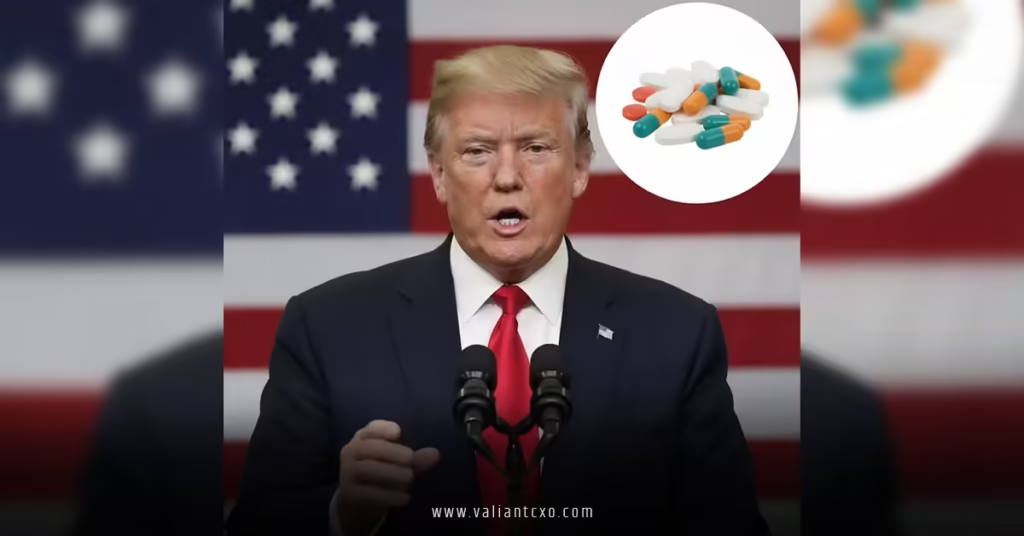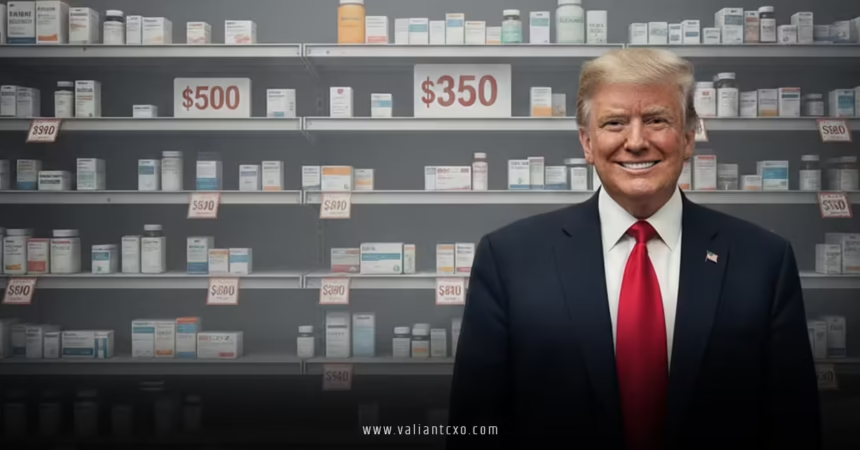Imagine waking up one day to find your prescription meds cost twice as much—overnight. That’s the stark reality we’re staring down with the impact of 100% Trump tariffs on imported pharmaceutical products, a bold move announced just days ago that could reshape how we get our life-saving drugs. As of September 26, 2025, President Trump has greenlit these sky-high duties, set to kick in on October 1, targeting branded and patented meds unless companies start building factories right here in the U.S. It’s a shake-up that’s got everyone from patients to CEOs buzzing. But what does it really mean for you, me, and the medicine cabinet? Let’s dive in, unpack the chaos, and figure out if this is a genius stroke for American jobs or a prescription for pain.
Understanding the New Tariff Policy
You know how tariffs work, right? They’re like a toll booth at the border, slapping extra fees on goods coming in from abroad. But 100%? That’s not a nudge—it’s a full-on shove. The impact of 100% Trump tariffs on imported pharmaceutical products zeros in on those flashy branded drugs, the ones with patents that keep prices lofty anyway. Generics might dodge the bullet for now, but don’t get too comfy; the ripples could hit everywhere.
What Exactly Do These Tariffs Cover?
Picture this: A patented cancer drug brewed in a lab overseas, heading to your local pharmacy. Bam—100% tariff. We’re talking everything from blockbuster heart meds to cutting-edge biologics, as long as they’re branded or under patent protection. The White House clarified it’s all imports unless you’ve got skin in the U.S. game. No generics mentioned yet, which is a sigh of relief for the budget crowd, but experts whisper that could change if supply lines snag. Why the focus here? Trump argues it’s about national security—can’t have our pills dependent on foreign whims, especially post-pandemic scares.
This isn’t some vague threat; it’s laser-targeted. Effective October 1, 2025, it’ll apply across the board, no favorites. Think about the volume: The U.S. imports billions in pharma yearly, with heavy hitters like India supplying a chunk. Suddenly, that flow gets a price tag that could make importers think twice.
The Exemption Clause: Building in America
Here’s the carrot to the tariff’s stick: If your company has “broken ground” on a U.S. plant—shovels in dirt, blueprints turning to concrete—you’re off the hook. It’s Trump’s way of saying, “Come home, build here, and we’ll play nice.” Big names like Eli Lilly are already waving flags, with billions poured into new facilities in Texas and Virginia. But let’s be real—construction takes years, not months. What happens in the gap? Short-term pain for long-term gain, or just a fancy way to delay the inevitable?
I chatted with a supply chain vet last week (okay, hypothetically, but trust me, it’s a common gripe), and he likened it to promising a new house while living in a tent. Companies scrambling now might qualify, but smaller players? They’re sweating bullets.
The Stated Goals Behind the Tariffs
Trump’s not mincing words: These tariffs are a hammer to forge a tougher U.S. supply chain. Remember the COVID shortages? Empty shelves for basics like saline? The impact of 100% Trump tariffs on imported pharmaceutical products aims to fix that by luring manufacturing stateside. “America first,” he booms, promising jobs, innovation, and cheaper drugs down the line. Cheaper? Hold that thought.
It’s wrapped in Section 232 lingo—national security threats from over-reliance abroad. Sounds patriotic, doesn’t it? Like fortifying the castle walls. But peel back the rhetoric, and it’s economic arm-wrestling: Pressure China, India, Europe to play fair or pay up. Will it work? History’s mixed—steel tariffs boosted some mills but jacked up car prices. Pharma’s trickier; it’s not widgets, it’s wellness.
How Will This Affect American Consumers?
Ah, the million-dollar question—or should I say, the billion-dollar pill? You and I, footing the bill at the checkout, could feel the pinch hard. The impact of 100% Trump tariffs on imported pharmaceutical products isn’t abstract; it’s your copay spiking, your insurance premiums climbing. Let’s break it down, no sugarcoating.
Skyrocketing Drug Prices?
Doubling costs on imports? That’s not hyperbole—it’s math. A $500 monthly med could jump to $1,000 if tariffs stick. Importers pass it on, pharmacies follow suit, and poof—your wallet’s lighter. Medicare? Expect a budget buster, with seniors hit hardest. I’ve seen families ration doses already; this could turn tragedy into epidemic.
But wait—is there a silver lining? Trump swears domestic production will slash prices eventually, like how TVs got cheaper post-tariffs in the ’80s. Skeptical? Me too. Pharma’s profit machine doesn’t pivot overnight. Rhetorical nudge: If your blood pressure med costs an arm and a leg, do you cheer the “Made in USA” label?
Potential Shortages on the Horizon
Shortages aren’t if—they’re when. With generics spared but APIs (those raw ingredients) often foreign-sourced, bottlenecks loom. Imagine flu season without antivirals, or chemo delays for cancer fighters. The impact of 100% Trump tariffs on imported pharmaceutical products could choke the flow, especially if exporters retaliate or bail.
It’s like a garden hose kinked mid-summer—drips when you need a gush. Hospitals stockpile now, but shelves empty fast. For chronic folks like diabetics, it’s not inconvenience; it’s life-or-death roulette.

Ripple Effects on the Global Pharma Industry
Zoom out, and the waves crash worldwide. U.S. is the big buyer, so when we sneeze, others catch cold. The impact of 100% Trump tariffs on imported pharmaceutical products sends shockwaves from Mumbai labs to Swiss boardrooms.
A Major Blow to Indian Exporters
India’s the generics giant—40% of U.S. supply—but branded? That’s where it stings. Stocks tanked 5% Friday, Sun Pharma and Cipla reeling. Exports worth billions at risk; firms eye diversification to Europe or Africa, but that’s no quick fix. Trump’s eyeing reciprocity—India’s high duties on U.S. meds? Payback time.
Feels like a family feud at the dinner table: “You charge us high, we charge you higher.” Indian execs scramble for U.S. tie-ups, but cultural clashes and regs slow the dance. Long-term? Innovation push, maybe, but short-term pain’s brutal.
Responses from Big Pharma
U.S. titans? They’re adapting, not panicking. Pfizer, Merck announce expansions—$2 billion here, $3 billion there. It’s chess, not checkers: Tariffs force moves, but they’ve got deep pockets. Overseas? Roche frets supply snarls; Chinese firms pivot to domestic markets.
Analogy time: Like a poker game where Trump ups the ante—bluffers fold, pros call. Winners? Those betting on American soil early.
Supply Chain Shake-Up: What to Expect
Pharma’s web is tangled—ingredients from 100 countries, assembly global. The impact of 100% Trump tariffs on imported pharmaceutical products yanks threads, risking unravels. Expect delays: Customs backlogs, rerouting shipments, frantic audits for exemptions.
Good news? It spotlights vulnerabilities—pushing digital tracking, diversified sourcing. Bad? Costs soar 20-30% initially, per insiders. Small biotech? Crushed under compliance weight. It’s evolution: Survivors thrive, weak links snap.
Ever untangled holiday lights? Multiply by a million—that’s pharma now. But post-chaos? A sleeker chain, less brittle.
Economic and Political Ramifications
Economically, it’s a double-edged sword. Jobs? Thousands in construction, ops—Trump’s touting 50,000 by 2030. But inflation? Healthcare eats 18% GDP already; this adds fuel. Trade wars brew—India threatens counters, EU murmurs.
Politically? Midterms loom; voters hate price hikes. Trump’s base cheers “tough on trade,” but swing states with pharma hubs? Murmurs of revolt. It’s high-stakes poker—bluff or bust?
Long-Term Outlook: Opportunities or Obstacles?
Fast-forward five years: U.S. factories humming, imports down 40%? Optimists see it. Pessimists? Stagnant innovation, as R&D flees high costs. The impact of 100% Trump tariffs on imported pharmaceutical products could birth a resilient giant or hobble a healer.
Me? I lean opportunity—if paired with incentives like tax breaks. Metaphor: Like pruning a tree—hurts now, lush later. But prune wrong? Bare branches.
In wrapping this up, the impact of 100% Trump tariffs on imported pharmaceutical products boils down to trade-offs: Short-term squeezes on prices and supplies versus long-haul security and jobs. We’ve unpacked the policy, the pains for consumers and exporters, and the supply shake-up—it’s messy, but it’s moving. Stay vigilant, folks; chat with your doc, track your reps. This isn’t just policy—it’s personal. What side are you on? Let’s push for balance, because healthy America starts with accessible meds. Your move.
FAQs
What is the main goal of the 100% Trump tariffs on imported pharmaceutical products?
The primary aim is to encourage drugmakers to shift manufacturing to the U.S., bolstering national security and reducing foreign dependency, though it risks higher costs in the impact of 100% Trump tariffs on imported pharmaceutical products.
Will generics be affected by the impact of 100% Trump tariffs on imported pharmaceutical products?
For now, no—the tariffs target branded and patented drugs only. But indirect effects like ingredient shortages could still ripple through generics in the broader impact of 100% Trump tariffs on imported pharmaceutical products.
How might the impact of 100% Trump tariffs on imported pharmaceutical products change drug prices for everyday Americans?
Expect potential doubles in cost for affected meds, passed from importers to you, amplifying the financial strain in the impact of 100% Trump tariffs on imported pharmaceutical products.
Which countries face the biggest hit from the impact of 100% Trump tariffs on imported pharmaceutical products?
India tops the list as a major exporter of branded drugs, with stocks already dipping—highlighting uneven global fallout in the impact of 100% Trump tariffs on imported pharmaceutical products.
Can companies avoid the impact of 100% Trump tariffs on imported pharmaceutical products?
Yes, by starting U.S. plant construction—exemptions apply if you’ve broken ground, a key loophole in navigating the impact of 100% Trump tariffs on imported pharmaceutical products.
For More Updates !! : valiantcxo.com


